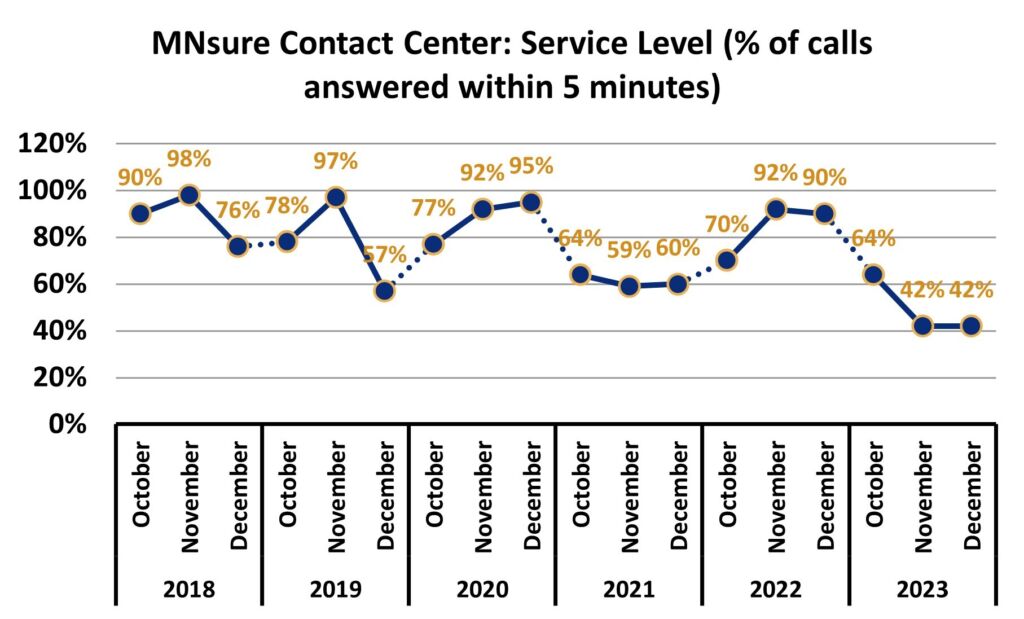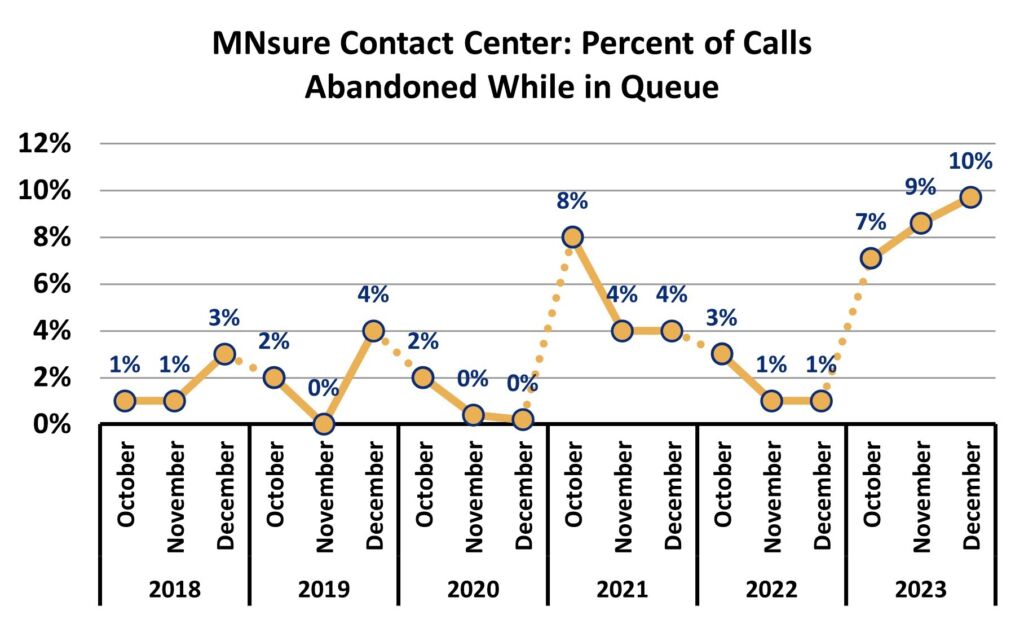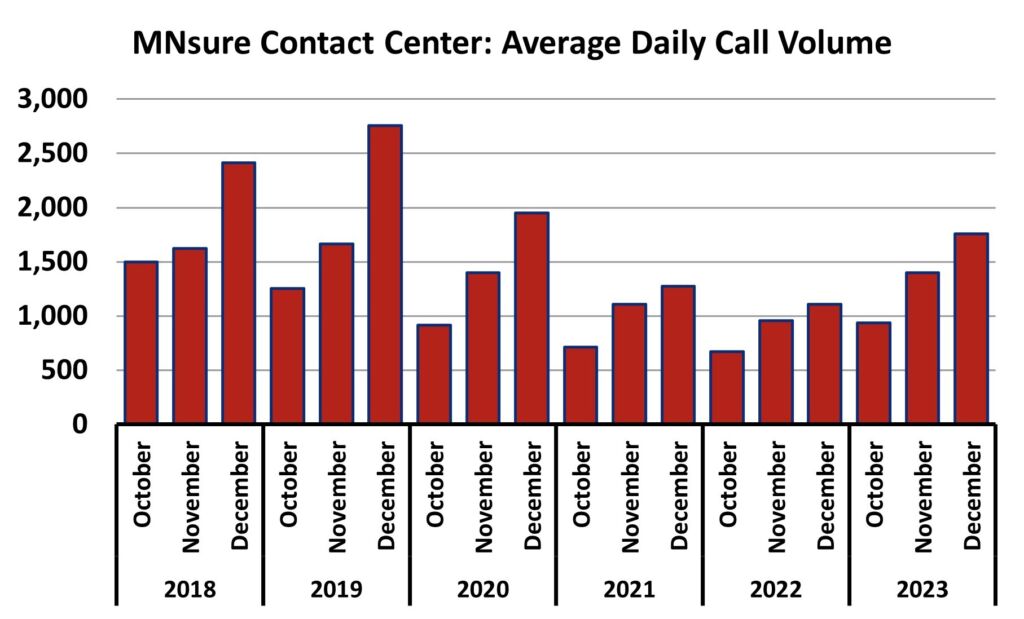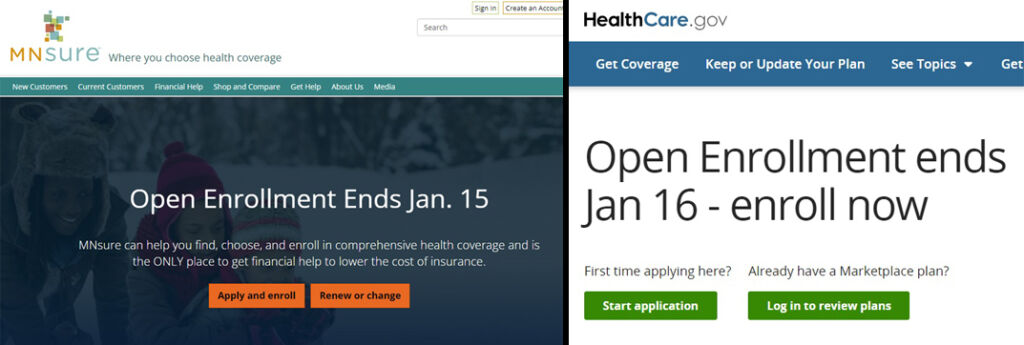MNsure closes call center before enrollment deadline, despite record low service levels leading to abandoned calls
Last week Gov. Tim Walz announced that a record 146,445 people signed up to buy health insurance through MNsure during the annual open enrollment period that ended on January 15. While MNsure may have set a record, many Minnesotans may have still walked away from MNsure without coverage after not getting timely customer service through MNsure’s contact center.
Key metrics from the MNsure dashboard presented at the January board meeting show the contact center performed worse than any other enrollment period over the past six years. Adding to this poor service level, MNsure decided to completely close the contact center over the final three days of enrollment because the days landed on the Martin Luther King Day holiday weekend.
Demand for enrollment services peaks in December
MNsure is the state’s health insurance Exchange established under the Affordable Care Act. During an open enrollment period each year, lower-income people can buy coverage through MNsure with federal premium subsidies. Open enrollment begins November 1 and runs through December 15 for coverage that starts January 1 and continues through January 15 for February 1 coverage. This timing makes October to January the most critical time of the year for MNsure’s enrollment services and consumer supports.
As a senior advisor to the administrator of the Centers for Medicare & Medicaid Services (CMS), I helped manage open enrollments for HealthCare.gov — the federal Exchange — and am fully aware of how critical certain times during the enrollment period can be. Similar to how a pilot must be laser focused on takeoffs and landings, insurance Exchanges must be laser focused on the first and last days of open enrollment. That’s when the consumer volume spikes.
The MNsure contact center consistently reports the highest volume during the week of December 15 because people always procrastinate to meet the deadline to enroll in full year coverage. If you lose people on December 15 due to customer service issues, there is a substantially higher risk they will go without coverage.
Long wait times increase abandoned calls to MNsure
MNsure is governed by a board that holds several public meetings through the year with regular performance updates. Each year, their January meeting provides the first look at how MNsure performed during the critical annual open enrollment period. A review of these January board meeting presentations shows that people reaching out for help to the MNsure contact center during the 2024 open enrollment period experienced the lowest service level over the past six years of available data.
MNsure began reporting consistent monthly contact center performance data leading into the 2019 plan year. The following figure shows the contact center service level measured by the percent of calls answered within five minutes. Over two of the past three years the service level hit higher than 90 percent during December — the time when consumers put the most strain on MNsure to enroll for a full year of coverage. This past December, MNsure’s service level plummeted to a low of 42 percent. That is substantially lower than the previous low of 57 percent in December 2019.

These longer wait times led to a record rate of people abandoning their calls. During December — again, the most critical time for enrollment — the percent of calls abandoned while in queue hit 10 percent. The next figure shows this rate was substantially higher than any December over the period MNsure reports. By comparison, the abandonment rate was just 1 percent last year and never reached higher than 4 percent in any other year.

Higher call volumes are no excuse
During their board meeting last week, MNsure CEO Libby Caulum appropriately called attention to the MNsure contact center dashboard in her presentation. However, nothing in her presentation suggested any serious concern over the contact center’s poorer performance. Instead, she quickly noted the poorer performance can be explained by “unusually high” average daily call volumes. She specifically cited a 53 percent increase in call volume in the first eight weeks of open enrollment over the prior year. While she acknowledged the increase in calls put pressure on the system, she focused her remarks on describing the benefits of new consumer tools and praising MNsure’s contact center and operations staff for their “professionalism and resiliency.”
This explanation suggests longer wait times and more abandoned calls were inevitable due to the higher call volumes. Yet, by these metrics, MNsure’s contact center performed far better in the past under higher call volumes. Contrary to Caulum’s claims, the call volume during open enrollment was not unusually high when compared to the last six years. As the following figure shows, the call volume for November and December was quite average for the past 6 open enrollment periods. In fact, call volume for November and December was actually about 3 percent less than the average over this time period.

These data show that higher call volumes cannot be an excuse for the contact center’s poor performance. The contact center performed far better in 2019 when the November and December call volume was 40 percent higher and performed nearly flawlessly in 2020 when call volume was 6 percent higher.
MNsure should have been prepared for higher call volumes
It’s true the call volume was higher over the past two open enrollment periods, but MNsure knew call volume would increase because Medicaid continuous enrollment is now ending. During COVID, states agreed to keep people continuously covered in Medicaid in exchange for higher federal Medicaid funding. This ended on April 1 last year and states are now in the process of redetermining Medicaid eligibility. Therefore, thousands of Minnesotans who were on Medicaid now qualify for premium subsidies on MNsure and are entering the enrollment process with questions for the contact center.
Exchanges need the flexibility to scale their consumer services up and down to meet daily changes in consumer demand. On December 15—the last day of enrollment for full year coverage—consumer demand spikes in every Exchange across the country. This forces every Exchange to put in place systems that scale to meet this spike. That makes it hard to understand why MNsure was not able to scale their contact center to meet the call volume, especially when it was a lower call volume than pre-COVID open enrollments. MNsure should have been well prepared to meet an even larger volume of calls.
MNsure closes the contact center the weekend before the final enrollment deadline
Despite knowing the contact center performed poorly ahead of the December 15 deadline, MNsure then chose to close the contact center over the entire Martin Luther King Day holiday weekend. Because Martin Luther King Day landed on January 15, the contact center was officially closed the final three days of the open enrollment period. Therefore, consumers had no access to the contact center during the second busiest period of the open enrollment season. As their post on X shows, MNsure was transparent about the closure.
Moreover, unlike HealthCare.gov, MNsure also chose not to extend open enrollment to January 16 to accommodate the holiday. This would have at least provided one final day for consumers to call the contact center during standard business hours.

To justify the closure, Caulum told the MNsure board about the processes in place to allow people to finish enrollment after the deadline if they had started before the deadline. She explained, “We really do not take the decision to have our contact center close lightly. So, this process is really in place to make sure that nobody misses out on coverage just because we are not on the phone.” Caulum’s statement suggests the backstop process for closing the contact center is foolproof. Yet there are always people who don’t follow up and enroll if they face any difficulties with the process.
HealthCare.gov offers a similar backstop. While I was at CMS, we never used it to justify reducing customer service during the open enrollment period. It was always there to ensure people had a failsafe if they ran into unexpected problems.
No media attention, no board scrutiny
I can only imagine the media circus that would have happened if the Trump administration had shuttered the HealthCare.gov call center on any weekend during open enrollment, let alone the weekend of the final deadline. Without question, people would have labeled the closure sabotage and claimed we were intentionally setting up barriers to coverage. Not surprisingly, there’s no uproar from the media or liberal consumer advocates when the Walz administration “sabotages” coverage.
While media silence might not be surprising, the MNsure board should be providing meaningful oversight. These board members see the contact center dashboard at every meeting and are the best positioned to identify and understand any issues with the contact center. Yet, at the January board meeting, not one MNsure board member asked Caulum any follow-up questions. Moreover, a review of MNsure board materials suggests the board never discussed significant new federal standards for state-based Exchanges that CMS proposed on November 15.
Contact center closure would violate new standards proposed by CMS
Every year CMS updates federal standards on health insurance and Exchanges through the annual payment notice rule. The proposed 2025 Payment Notice includes seven major policy changes that remove state discretion over important aspects of administering state exchanges. The MNsure board had an opportunity to comment on these proposals until January 8. Because the annual payment notice always touches on state Exchanges, the MNsure board has a clear duty to discuss it and comment if necessary. But it appears MNsure offered no comment, unless the staff commented without the board’s approval. In contrast, the Pennie board of directors who govern Pennsylvania’s Exchange held a meeting on January 5 focused exclusively on approving comments to this CMS rule. At this meeting, the Pennie board discussed and presumably approved comments to CMS that support three and oppose two of the federal proposals.
Notably, keeping the contact center closed in the evening and on weekends will violate one of the new federal standards if finalized for the next open enrollment period. The rule proposes that “the Exchange call center must provide consumers with access to a live call center representative during an Exchange’s published hours of operation ….” MNsure’s contact center hours fail to meet this standard each day of the year. The MNsure online marketplace is open 4 a.m. to midnight every day. CMS is apparently unaware of this fact as they specifically noted they “believe that all State Exchange call centers already meet the minimum standards being proposed ….”
Contact center recently transitioned to fully in-house model
While MNsure may have failed to alert board members to the opportunity to comment on the CMS rule, they did remind the board at their March 2023 meeting that the contact center transitioned from an outsourced model to a fully in-house model for the 2022 open enrollment period. After the transition, the contact center reported substantially higher consumer satisfaction rates. This suggests that going in-house at least initially created a better consumer experience. However, this all happened during COVID which makes comparisons difficult.
As noted previously, Exchanges need the ability to scale up and down to meet dramatic shifts in call volumes and website traffic. While in-house staff may have been better trained to respond to consumer questions and resolve issues, it is likely MNsure’s in-house model does not have as large a capacity to scale in response to higher call volumes as a vender model. A vendor hires staff to work with multiple call center contracts and can shift resources from one client to the next to meet changing volume patterns. Without knowing exactly how MNsure scales their resources, it would seem they will have far less flexibility than a vendor once they have set their staffing levels for the year.
Did MNsure sacrifice longer waits and abandoned calls for better answers to people who stayed on the line? How does MNsure’s contact center performance compare to other state Exchanges? Is there a need to revisit the move to a full in-house model? How can MNsure justify closing the contact center in the final three days when they know call volumes are up? Could MNsure take better advantage of private web brokers to give consumers more options for help? These are obvious questions an attentive and consumer-focused board member should be asking.
MNsure could learn something from HealthCare.gov
The HealthCare.gov call center operates 24 hours a day, 7 days a week. MNsure’s contact center generally opens only during the standard workday—Monday to Friday, 8 a.m. to 4 p.m. It’s surprising that MNsure thinks this level of service is adequate, especially when lower-income people with standard work schedules often have less flexibility to take time off. MNsure should at least keep the call lines open through the final weekend just like HealthCare.gov.
Under the Trump administration, HealthCare.gov also implemented technology improvements that let private web brokers enroll people in subsidized coverage using HealthCare.gov’s backend eligibility and enrollment systems. This private enrollment pathway is called enhanced direct enrollment, or EDE. The Biden administration continues to support EDE and recently noted that EDE continues to account for a growing portion of enrollments. More enrollments through EDE private sector partners relieves a substantial amount of pressure on HealthCare.gov’s resources.
Back in 2013, American Experiment published a working paper offering three strategies for implementing a state Exchange. The third strategy recommended the EDE approach that HealthCare.gov eventually implemented. The paper noted how Exchanges operate like Expedia and Orbitz. The paper then offered two key reasons why consumers would benefit from multiple avenues to buy subsidized health insurance just like they benefit from multiple avenues to buy airline tickets.
- First, more sales outlets with a financial incentive to connect people with coverage will increase the number of people with health coverage.
- Second, it will increase the service level of the public Exchange because it will need to compete with private Exchanges.
I’ve long had the impression that MNsure does a good job coordinating with private brokers. It was one of the first Exchanges to provide an online tool to find a private broker for more help. But there’s always room for improvement and, looking forward, MNsure should be working to create multiple avenues for people to enroll online. More online avenues would mean more call center options. MNsure should welcome this competition.
Summing up
As a former political appointee at CMS focused on health insurance and Exchanges, I was on the frontlines of responding to all the major criticisms launched at the Trump administration. So, I do empathize with the challenges MNsure’s board and staff face when managing one of the more politically charged public programs for the state. There’s always a lot going on underneath the hood that steers management and policy decisions. I don’t doubt there are some very good reasons to explain the contact center’s lower performance. But as a public entity governed by a board appointed by Gov. Walz, they need to be more transparent.